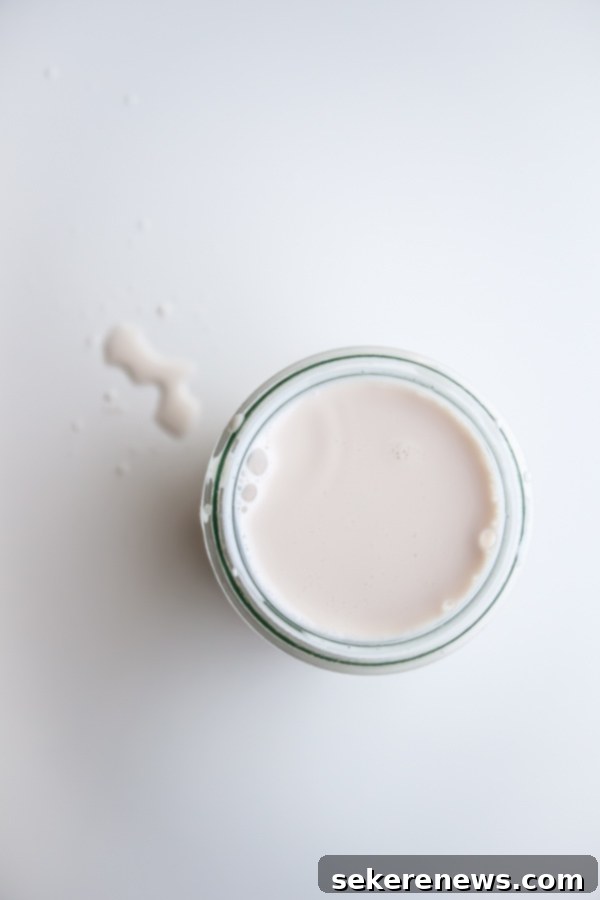Homemade Hazelnut Milk: Your Ultimate Guide to Creamy Plant-Based Goodness
A simple tutorial for how to make homemade hazelnut milk!

There’s nothing quite like the taste of freshly made nut milk, and it’s been far too long since I embraced the simple joy of crafting my own. While store-bought options are convenient, they often come with added sugars, thickeners, and preservatives. Making your own nut milk at home offers unparalleled freshness, flavor, and control over every ingredient. Forget the awkward terminology; let’s dive into the pure delight of homemade goodness.
And yes, when it comes to straining, the right tools make all the difference. While the term “nut milk bag” might sound a bit quirky, these specialized bags are incredibly effective for achieving a silky-smooth texture. They genuinely exist and are a game-changer for homemade plant-based milks.
Why Choose Homemade Hazelnut Milk?
For years, I considered myself a dairy milk purist, finding it hard to fully commit to plant-based alternatives. Many nut milks, particularly certain almond varieties, often left me wanting more – sometimes they felt thin, or had an unappealing bitterness. This skepticism made my venture into making nut milk from scratch a rare occurrence. However, a recent craving for something truly special led me to try homemade hazelnut milk, and I was absolutely floored by the results. It has quickly become my favorite plant-based milk, and for very good reasons!


The Distinctive Richness of Hazelnuts
Hazelnut milk stands out from other nut milks due to its naturally creamy texture, rich, slightly sweet, and distinctively nutty flavor. Unlike some counterparts, it rarely carries that underlying bitterness that can be off-putting. This inherent richness means it’s delicious enough to drink straight from a glass, serve over cereal, or stir into your morning coffee, adding a luxurious depth that elevates any beverage.
While hazelnuts can be a bit more expensive than almonds or oats, the superior taste and texture of homemade hazelnut milk make it a worthwhile indulgence. Think of it as a special occasion treat that you can enjoy any day, a little luxury that transforms your everyday routines. It’s also incredibly versatile – not just for drinking, but as a fantastic base for smoothies, a creamy addition to hot chocolates, or even a flavorful component in many baking recipes.
Transform Your Milk: Delicious Variations
Beyond its delightful natural state, homemade hazelnut milk serves as an excellent canvas for flavor experimentation. One of the simplest and most satisfying transformations is into a decadent chocolate hazelnut milk. With just a few extra ingredients, you can whip up a rich, sweet, and incredibly satisfying drink that rivals any store-bought version.


Simply add a heaping tablespoon of unsweetened cocoa powder and a pitted Medjool date to your fresh hazelnut milk in the blender. The date provides natural sweetness and a hint of caramel, perfectly complementing the chocolate and hazelnut flavors. Blend until completely smooth, and you’ll have a treat that’s perfect for chilly evenings, a post-workout pick-me-up, or a satisfying dessert. I haven’t experimented thoroughly just yet, but I also believe this creamy milk would be excellent in a variety of baked goods, adding a moist, nutty undertone to cakes, muffins, or even pancakes (see the recipe notes for additional tips, especially for the leftover hazelnut pulp!).

Homemade Hazelnut Milk
Pin
Review
SaveSaved!
Equipment
-
Vitamix 5200 Blender
Ingredients
Homemade Hazelnut Milk:
- ¾ cup hazelnuts
- 3½ cups (840 mL) cold water
- ¼ teaspoon vanilla extract
Chocolate Hazelnut Milk:
- 1 cup (240 mL) homemade hazelnut milk see recipe above
- 1 heaping tablespoon (8 g) unsweetened cocoa powder
- 1 Medjool date pitted
Instructions
-
Homemade Hazelnut Milk: Place the hazelnuts in a bowl or blender container. Add the cold water and allow the hazelnuts to soak in the refrigerator, covered, for at least 8 hours, or overnight.
-
Once the hazelnuts have soaked overnight, transfer to the blender and add the vanilla extract. Cover with lid and blend until very smooth, white in color, and hazelnuts are finely blended.
-
Line a fine-meshed sieve with a coffee filter, cheesecloth (secured with rubber band), or nut bag and set over a large container. Strain the hazelnut milk and separate the hazelnut pulp (see notes for ideas on how to use the pulp). Pour slowly and allow the milk to strain. If you are using a coffee filter, this step can take as long as 30 minutes or longer.
-
Chill and store the hazelnut milk in a covered container in the fridge for up to 2 to 3 days. Shake well before using.
-
Chocolate Hazelnut Milk: Place cold hazelnut milk, cocoa powder, and the date in a blender and puree until very smooth. Serve immediately.
Tips for Success:
- Leftover hazelnut pulp can be dried in a dehydrator, or used in baked applications or added to smoothies.
Mastering the Art of Homemade Hazelnut Milk: Essential Tips
While the recipe itself is straightforward, understanding a few key techniques can elevate your homemade hazelnut milk from good to absolutely phenomenal. Here are some detailed tips to ensure your success:
1. The Power of Soaking
Soaking the hazelnuts is a non-negotiable step for several reasons. Firstly, it softens the nuts, making them much easier to blend into a smooth, creamy liquid, especially if you don’t own a high-powered blender. Secondly, soaking helps to “activate” the nuts by breaking down enzyme inhibitors, which can improve digestibility and nutrient absorption. An overnight soak (at least 8 hours) in cold water is ideal. This process also contributes to a creamier final product, as the nuts absorb water and become plump.
2. Blending for Ultimate Smoothness
For the best results, a high-speed blender like a Vitamix is highly recommended. It will pulverize the soaked hazelnuts into an incredibly fine consistency, ensuring minimal grit in your finished milk. Blend for at least 60-90 seconds, or until the liquid appears uniformly opaque and white. If you have a less powerful blender, you might need to blend in shorter bursts and for a slightly longer total time, pausing to scrape down the sides.
3. Choosing Your Straining Method
Straining is crucial for separating the smooth milk from the hazelnut pulp. You have a few options, each with its pros and cons:
- Nut Milk Bag: This is arguably the most efficient and effective method. Nut milk bags are finely woven, durable, and allow for quick straining while retaining virtually all the pulp. Simply pour the blended mixture into the bag, gather the top, and gently squeeze the milk out. This yields the creamiest, smoothest milk with the least effort.
- Cheesecloth: If you don’t have a nut milk bag, several layers of cheesecloth (at least 2-4) can work. Line a fine-mesh sieve with the cheesecloth, place it over a large bowl, and pour the mixture in. Gather the edges and squeeze. Be aware that some finer pulp might still pass through if the cheesecloth isn’t layered thickly enough, and it can be a bit messier than a nut milk bag.
- Fine-Mesh Sieve with Coffee Filter: This method provides excellent filtration, ensuring a very smooth milk, but it is by far the slowest. The coffee filter will catch even the tiniest particles, but the straining process can take up to 30 minutes or even longer, requiring patience. It’s best for smaller batches if time is a constraint.
Whichever method you choose, remember to pour slowly and let gravity do most of the work before gently squeezing out any remaining liquid.
4. Proper Storage for Freshness
Homemade hazelnut milk is a fresh product and should be treated like dairy milk. Store it in a tightly sealed container (a glass bottle or jar works well) in the refrigerator. It typically lasts for 2 to 3 days. Natural separation is common, so always give it a good shake before each use to redistribute the solids and ensure a creamy consistency. If you notice any off-smells or tastes, it’s best to discard it.
5. Reimagining Leftover Hazelnut Pulp
Don’t let that leftover hazelnut pulp go to waste! It’s a treasure trove of fiber and nutrients, ready to be repurposed. Here are some fantastic ideas:
- Hazelnut Flour: Spread the pulp thinly on a baking sheet and dehydrate it in a low oven (around 200°F / 95°C) or a dehydrator until completely dry and crumbly. Once dry, you can process it in a food processor into a fine hazelnut flour, perfect for gluten-free baking, adding to granola, or thickening smoothies.
- Energy Bites/Bars: Mix the pulp with some dates, oats, cocoa powder, a sweetener (like maple syrup), and any other desired add-ins (e.g., chia seeds, shredded coconut) to create delicious no-bake energy bites.
- Crackers: Combine the pulp with some flour (gluten-free or regular), water, herbs, and spices to make savory crackers. Roll it out thin and bake until crispy.
- Smoothie Booster: Simply add a spoonful or two of fresh or dried pulp to your morning smoothie for an extra fiber and nutrient boost.
- Baked Goods: Incorporate the fresh pulp directly into muffin batter, bread dough, or cookie recipes for added texture and a subtle nutty flavor.
Embrace the Homemade Difference
Making your own hazelnut milk is a rewarding process that allows you to enjoy a superior product, free from unnecessary additives, and tailored to your taste. The rich, creamy texture and distinct nutty flavor are incomparable, making it a delightful addition to your plant-based kitchen. Whether you’re enjoying it plain, as a luxurious chocolate treat, or incorporating it into your cooking and baking, homemade hazelnut milk is truly liquid gold. Give it a try, and taste the difference for yourself!
